|

Summer 2002 (10.2)
Pages
34-40
Azerbaijan's Oil History
A Chronology
Leading up to the Soviet Era
by Mir Yusif Mir-Babayev
  Azerbaijan has been linked with oil
for centuries, even for millennia. Medieval travelers to the
region remarked on its abundant supply of oil, noting that this
resource was an integral part of daily life there. Azerbaijan has been linked with oil
for centuries, even for millennia. Medieval travelers to the
region remarked on its abundant supply of oil, noting that this
resource was an integral part of daily life there.
By the 19th century, Azerbaijan was by far the frontrunner in
the world's oil and gas industry. In 1846 - more than a decade
before the Americans made their famous discovery of oil in Pennsylvania
- Azerbaijan drilled its first oil well in Bibi-Heybat. By the
beginning of the 20th century, Azerbaijan was producing more
than half of the world's supply of oil.
During its early Oil Boom, between 1885 and 1920, Azerbaijan
benefited greatly from the expertise of well-known chemists and
geologists from Europe and Russia. Baku's rich oil barons sought
out the best advice that the scientific world had to offer, seeking
recommendations from important figures like German chemist Carl
Engler and Russian chemist Dmitry Mendeleyev. As a result, innovative
new techniques such as rotary drilling and gaslift were tested
for the first time in Azerbaijan.

Above: The Nobel Brothers' oil wells in Balakhani,
a suburb of Baku. The derricks were so close to each other, making
the risk of fire eminent, and the noise level horrendous. Photo:
Asbrink Collection.
In 1920, when the Bolsheviks captured Azerbaijan, all private
property - including oil wells and factories - was confiscated.
After that, the Republic's entire oil industry was directed toward
the purposes of the Soviet Union, including a tremendous output
of oil for the World War II effort.
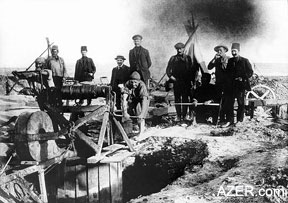  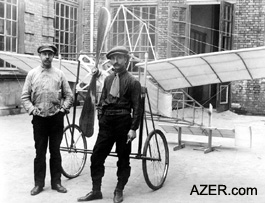
Left: Hand-dug wells in Azerbaijan. Right: Students of Baku Technical College (now the Oil
Academy) standing beside the airplane they constructed in 1910.
Photo: Azerbaijan National Archives.
Here Azerbaijani chemistry
professor Mir-Yusif Mir-Babayev identifies the milestones of
Azerbaijan's rapid oil development up until 1920. Considering
the progress that was made in leaps and bounds back then, one
has to wonder: what would Azerbaijan's oil industry be like today
if the Bolsheviks had not interrupted their momentum?
______
9th Century
Arabian traveler Baladzori (Al Belazuri Ahmad, died ca. 892)
wrote that political and economic life on Absheron had long been
connected with oil.
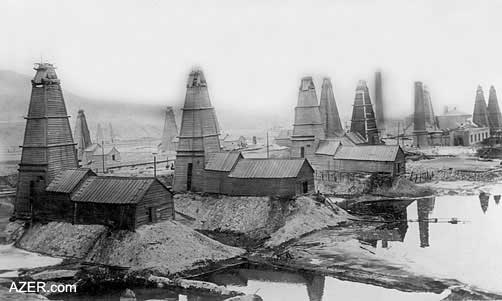
Above: Oil wells in the vicinity of Baku pumping
oil into reservoir lakes more than 100 years ago. The ecological
disaster still plagues the region. Photo: Azerbaijan National
Archives.
10th Century
Arabian historian Masudi-Abdul-Hussein (9th century-957) identified
two main sources of black oil and white oil (kerosene) on Absheron.
Arab historian Istahri-Abu Iskhak
described how the people of Baku used soil soaked in oil as fuel.
  13th Century 13th Century
After visiting Absheron, Arab historian Muhammad Bekran wrote
about the shaft extraction of oil in Balakhani (today, a suburb
of Baku).
Right: Camel caravans in Baku late 1800s.
Oil Baron Taghiyev imported the first car to Azerbaijan. By 1911,
Baku had 11 cars. Photo: Azerbaijan National Archives.
14th century
In "The Travels of Marco Polo," the world-famous Venetian
traveler Marco Polo (1254-1324) indicated that oil from Baku
was being exported to Near Eastern countries. He also described
the use of oil as an unguent used in therapeutic healing.
1594
An inscription inside a well 35m deep in Balakhani indicated
the date of construction and the name of the builder - Allah
Yar Mammad Nuroghlu.
1636
German diplomat and traveler Adam Oleari (1603-1671) described
Baku's 30 oil wells and said that oil gushed out of them with
a mighty force. He identified both brown and white oil and wrote
that there was a greater quantity of the brown.
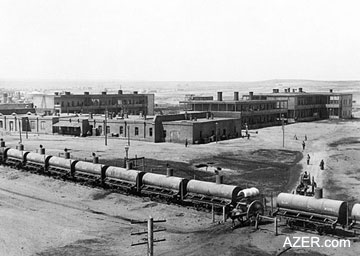  1647 1647
Turkish traveler Evliya Chelebi traveled to Baku to study and
describe its oil fields. He noted that from olden times the political
and economic life in this region had been closely connected with
oil.
1683
Naturalist and traveler Engelbert Kaempfer (1651-1716), Secretary
of the Embassy of Sweden to Persia, visited Baku and provided
a detailed description of Absheron's oil resources. He wrote
that oil was transported via wineskins on four-wheeled carts
to Shamakhi and Baku. From Shamakhi it was taken across country
on camels. From Baku it was taken by sea to the Uzbek and Cherkassy
regions and to Dagestan.
Above:
Train ready for departure
in Baku. Ludvig Nobel constructed the tank cars, and had them
produced in Riga, Russia. Photo: Asbrink Collection.
1723
Czar Peter the Great (1672-1725) issued laws related to oil extraction.
In his letter to General Mikhail Matyushkin, who occupied Baku,
the Czar demanded "1,000 poods of white oil or as much as
possible, and the search for an oil consultant specialist."
[A pood is a Russian unit of weight equal to 16.38kg.]
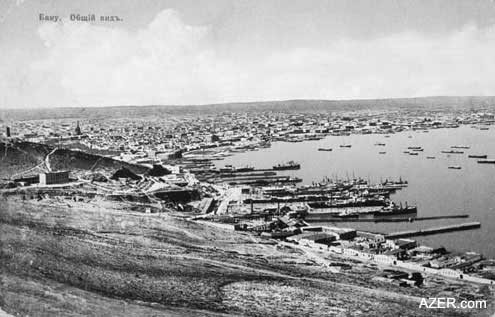
Above: Early view of Baku developing during
the Oil Boom, late 1800s. View from Bibi-Heybat region. Photo:
Azerbaijan National Archives.
1733
Physician Ioann Lerkh, employee of the Russian Embassy in Persia,
visited Baku and described Absheron oil fields in detail, confirming
that oil had been extracted in Baku since time immemorial.
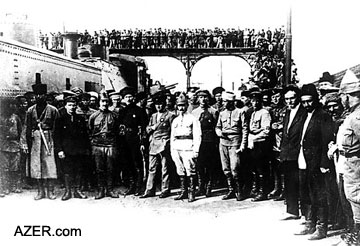  1739 1739
Based on materials from the famous hydrographer Fedor Soymonov
(1692-1780), academician V.I. Veitbrecht published an article,
"About Oil", which contained considerable information
about oil on Absheron. The article was published in the scientific
magazine "Notes on List" (in Russian "Primechaniya
na Vedomosti") where he described the Absheron oil wells
and provided a plan of the oil and gas fields.
1741
Ioanas Hanvei, Director of the English-Russian trade company,
investigated the Baku oil fields and published his "Historic
Essay on English Trade in the Caspian Sea" in 1754 in London.
Above:
The Red Army (with their
armored train) entered Baku on April 27, 1920, demanding the
resignation of the Azerbaijan Democratic Republic (ADR) Parliament
and effectively ending Azerbaijan's control over its own oil
resources. Most of the Oil Barons fled to Iran, Turkey or Europe.
Photo: Azerbaijan National Archives.
1771
After visiting Baku, academician Samuel Gmelin confirmed that
in Surakhani (today, a suburb of Baku) there was a substance
known as "white oil" that was being distilled to produce
kerosene. He also described the technique of well oil extraction.
1781
While heading an expedition to the Caspian, Russian Count Voynovich
discovered oil and gas outcrops from the bottom of the sea near
Chilov island.
1803
Gasimbey Mansurbeyov from Baku began to extract oil from two
wells in the Bibi-Heybat Bay, at a distance of 18m and 30m offshore.
1823
In Balakhani, close to the Khalafi well, an inscription was found
that read: "This well was rebuilt 200 years ago."
1834
Nikolay Voskoboynikov, Director of the Baku oil fields, invented
a special distilling machine that produced kerosene from black
and white oil.
1837
The first oil-distilling factory on the Absheron Peninsula began
operating in Balakhani.
1846
At the suggestion of V.N. Semyonov, a member of the Caucasus
Head Management, a 21m well was drilled in Bibi-Heybat for oil
exploration. This event marked the first time in world history
that an oil well was successfully drilled. More than a decade
later, on August 27, 1859, "Colonel" Edwin L. Drake
(1819-1880) struck oil on American soil for the first time, in
Titusville, Pennsylvania.
1858-1859
Vasily Kokarev, Peter Gubonin and German baron N.E. Tornow built
the first factory in Surakhani, close to the Fire Worshippers'
Temple. The factory was used to produce kerosene out of "kir",
an asphalt-like substance.
1859
N.I. Vitte, a Tiflis [Tbilisi] pharmacist, built the second paraffin-producing
factory on Pirallahi island.
1863
Javad Malikov built an oil-distilling factory in Baku for producing
kerosene out of crude oil.
Dmitry Mendeleyev (1834-1907),
the chemist who developed the Periodic Table of Chemical Elements,
visited Baku for the first time to work at Kokarev's factory
(September 1863). Mendeleyev would visit Baku three more times
- May 1880, May 1886 and August 1886.
1866
Azerbaijan's first reservoir for oil storage, stocktaking and
release was built near Boyuk-Shor Lake.
1870-1880
Vladimir Markovnikov (1838-1904) carried out major work investigating
Absheron oil, resulting in the discovery of a new class of hydrocarbons
called "naphthenes". He later received the Professor
Pavel Ilyenkov Prize as well as a Gold Medal from the International
Oil Congress for "Investigating the Oil of the Caucasus."
1872
In February, a new law was issued on "The Rules for Oil
Fields and Excise from Photogen Production." The law put
an end to the buy-out system in Azerbaijan's oil industry.
The Haji Zeynalabdin Taghiyev Oil Trade Company was established.
Taghiyev (1823-1924 or, perhaps, 1838-1924) was revered as the
greatest philanthropist of all the oil barons in Baku.
1873
This year marked the beginning of oil well drilling on a massive
scale.
In July the first major oil
gusher - Vermishevsky - erupted in Balakhani. Within three months,
it had produced 90 million poods [1.5 billion kg] of oil.
Robert Nobel, the eldest brother
in the Nobel family, visited Absheron for the first time.
The Artemyev brothers, merchants
from Astrakhan (now part of Russia), organized the first marine
transportation of oil from Baku to Astrakhan.
Baku's oil factory region began
construction in what was, and still is, called "Gara Shahar"
(Black City).
1874
Vasily Kokarev (1817-1889) and Peter Gubonin founded the Baku
Oil Society Company.
1875
The Nobel brothers (Ludvig and Robert, with Alfred of Nobel Prize
fame as a partner) started their activities in Azerbaijan's oil
industry.
Oil fields began to be developed
in Absheron - specifically in Sabunchi, Zabrat and Romani (a
name given by the Romans when they were in Sumgayit).
1876
Konon Lisenko, Chair of Chemistry for the St. Petersburg Mining
Institute, visited Baku to study the reasons for the 1875 oil
crisis that had taken place in the Russian Empire. In 1878, he
published a monograph in St. Petersburg called "Oil Production,
According to the Latest Data." The monograph was one of
the first original oil-related publications ever written.
Ludvig Nobel (1831-1888) moved
from St. Petersburg to Baku.
1877
The Nobel brothers built the world's first oil-carrying steamship,
naming it "Zoroaster" after Zoroaster (628-551 BC),
a great religious reformer and the founder of Zoroastrianism,
which predated Islam in the region.
Oil pipeline construction was completed between the fields in
Sabunchi and Black City.
1878
Bibi-Heybat had its first oil gusher. Vladimir Shukhov (1853-1939)
supervised the project to build the first pipeline from Balakhani
to the Black City.
1879
On March 24, the Baku Department of the Royal Russian Technical
Society (in Russian - BO IRTO) was established. The Society played
a key role in the development of Azerbaijan's oil business.
On May 18, the Oil Production
Fellowship of the Nobel Brothers established the Nobel Frere
Petroleum Company.
Balakhani's first power station,
built by the Caucasus and Mercury Joint Stock Company, began
operation.
1880
Alexander Letniy, a famous chemist and technologist as well as
the discoverer and researcher of the process of pyrolysis, came
to Baku. In 1880-1882 he designed and constructed the first major
plant to produce benzene and anthracene from oil residuals via
pyrolysis.
1882
The Nobel Brothers' factories started distilling oil on a 24-hour
basis, based on an idea proposed by Dmitry Mendeleyev.
1882-1883
The Nobel Brothers built a private residence called Villa Petrolea
along with a splendid park (now called Nizami Park) for their
engineering and technical workers. The park is located in Baku
between what was known as the "Black City" (the oil
industrial section) and the "White City" (the residential
section). Famous garden expert E. Bekle from Poland was hired
as a consultant for the grounds. [British Petroleum calls their
present day office "Petrolea II" after the Nobel's
residence. It is located on the other side of the city from the
Nobel Residence in Bayil.]
1883
English traveler and writer Charles Marvin visited Baku's oil
fields. Between 1883 and 1886, he wrote "The Russians at
Marv and Herat," "The Region of Eternal Fire,"
"Petroleum Region of the Caspian," "Baku is the
Petroleum of Europe" and "Russia's Power of Attacking
India." All of these books were dedicated to the development
of the oil business in Absheron and the Transcaucasus.
Construction of the Caucasus
railroad was completed. This 514-verst (a verst is a Russian
unit of distance that is equal to 1.067km) railway system connected
Baku and Batum.
On May 16 the Rothschild Brothers
established the Caspian and Black Sea Oil Industry and Trade
Society.
Minister of State Property Michael Ostrovsky arrived in Baku
in September accompanied by his brother, the famous playwright
Alexander Ostrovsky (1818-1883), to discuss oil problems.
Movsumbey Khanlarov was the
first Azerbaijani to defend his Ph.D. thesis on chemistry at
German Strasbourg University. Within a year, he returned to Baku
and began working in the Baku Department of the Royal Russian
Technical Society (in Russian - BO IRTO), according to Mendeleyev's
recommendation.
1884
In Baku a special organization of entrepreneurs called the Council
of Baku Oil Industrialists was established. The group was under
the directorship of Ludvig Nobel until 1888.
Sidor Shibayev founded the Shibayev
Sidor Oil Industry fellowship.
1885
German chemist Carl Engler visited Baku to study the nature and
origin of Absheron oils.
For the first time in the history
of the oil industry, engineer G.V. Alekseyev built a machine
in Baku that produced kerosene by cracking petroleum asphalt.
1886
On January 11, Haji Zeynalabdin Taghiyev gave a speech at the
Baku Department of the Royal Russian Technical Society (in Russian
- BO IRTO) entitled "How to Get Out of the Oil Industry
Crisis?" In it, he presented a clear plan for the export
of Baku's kerosene. The report was so practical that it was printed
and sent to all members of the society and oil manufacturers.
In June, the Svet oil tanker transported Baku's kerosene from
Baku to London via Batum for the first time in world history.
Dmitry Mendeleyev's book "Baku
Oil Industry in 1886" was published, summarizing the results
of his oil-related investigations from the 1860s to 1886.
Mendeleyev gave a speech at
a meeting of the Baku Department of the Royal Russian Technical
Society entitled: "About the Measures that Will Contribute
to the Further Development of Baku's Oil Industry."
1887
In January a new publication called "The Works of BO IRTO"
appeared. It was the first periodical covering issues related
to the Russian oil industry in Baku.
Several oil industry and trade companies were established, including
the Oil Company belonging to Musa Naghiyev (1849-1919), the Caspian
Fellowship and the Russian Standard.
1888
On December 8 and 9, Russian Czar Alexander III (1845-1894) was
in Baku with his family. He visited the Nobel Brothers' factory
in Baku's "Black City" (Gara Shahar in Azeri) and the
oil industries of Rothschild's Caspian-Black Sea Society in Balakhani
and Sabunchi.
1889
In St. Petersburg, a Russian Nobel Prize was established and
named after Ludvig Nobel. The award was bestowed upon the individual
who succeeded in doing the best investigative work in the field
of metallurgy and oil industry. The prize, determined by IRTO,
amounted to 1,200 gold rubles. Three awards were given - in 1896,
1898 and 1905.
1892
Chemist and engineer Konstantin Kharichkov (1865-1921) went to
Baku to study the composition and chemical characteristics of
Baku oils. Kharichkov wrote more than 100 original scientific
works related to chemistry, the origins of oil and its processing.
1893
Oil industry organizations such as the oil company owned by Shamsi
Asadullayev (1840-1913) and the Russian-Caucasian Oil Society
were established.
The Union of Baku Kerosene Producers
was established in St. Petersburg to gain a monopoly over export
trade.
1896
In March, engineer-technologist Alexey I. Stepanov became the
first laureate of the Russian Ludvig Nobel Prize for his investigation
of "The Basics of Lamp Burning."
The oil industry and trade firms
I.A. Akhverdov and Caucasus were established.
1897-1907
The world's largest kerosene pipeline (829 verst, or 885 km,
long) was built between Baku and Batum. The pipeline belonged
to the Transcaucasus Railroad.
1898
The Rothschild brothers founded the Mazut Transportation Society.
By 1912, it already had 13 large tankers in the Caspian Sea,
plus other auxiliary ships.
1899
On January 10 a new biweekly publication called "The Oil
Business" appeared.
Two new oil and trade societies
were founded: the Souchastniki (Collaborators) and the Absheron
Oil Society.
The Nobel Brothers Company,
the largest oil company in Baku, extracted 93.2 million poods
[1.5 billion kg] of oil, amounting to 17.7 percent of Russia's
total production and 8.6 percent of the world's total oil extraction.
1899-1901
Baku's oil industry ranked first in the world in terms of total
oil extraction, with a total of 11.5 million tons a year. At
the time, the United States was only producing 9.1 million tons.
1900
The Alexander Benkendorf Oil and Trade Company was established
in Baku.
1901
The First International Nobel Prizes were awarded. The award
grew to be revered internationally as the most prestigious award
in the world and was established following the death of Alfred
Nobel (1833-1896) via the execution of his will. Alfred's wealth
was valued at 31 million Sweden crowns from his earnings from
his invention of dynamite and from his holdings in stock - about
12 percent of the Nobel Brothers Petroleum Company in Baku. Swedish
historian E. Brarbengren, who had access to the Nobel's family
archives, insists that it was the decision to allow withdrawal
of Alfred's money in Baku that was the "decisive factor
that enabled the Nobel Prizes to be established."
That first year, the Nobel Prizes
were awarded to Germany's Wilhelm Conrad Roentgen (Physics),
Holland's Jacobus Henricus van Hoff (Chemistry), Germany's Emil
Adolf von Behring (Physiology or Medicine), France's Sully Prudhomme
(Literature) and Switzerland's Jean Henri Dunant (Peace).
1902
Konstantin Kharichkov, Nikolay Zelinsky (1861-1953), Alexander
Butlerov (1828-1886) and Movsumbey Khanlarov developed the industrial
classification and methods for purifying Absheron oils.
Konstantin Kharichkov published
his fundamental work, "About the Composition and Chemical
Characteristics of Russian Oil Deposits" (in Baku).
In August the Nobel Brothers
implemented the first transportation of Baku kerosene to Afghanistan.
1903
Geologist and oil specialist Dmitry Golubyatnikov began a systematic
investigation of Absheron and predicted the availability of oil
deposits in Surakhani.
Konstantin Kharichkov published
his monograph, "Cold Fractionation of Oil" (in Baku).
1903-1904
The tankers "Vandal" and "Sarmat" were built
under the direction of Immanuel Nobel (the son of Ludvig Nobel).
1904
In Baku, a Russian Nobel Prize was established and named after
Immanuel Nobel. The prize was awarded for best works and inventions
in the oil industry. The prize, determined by BO IRTO, was worth
1,000 gold rubles.
1905
Marking a first for the world's oil industry, the principles
of oil compression were applied to the wells in Balakhani.
1906
The first "white oil" gusher appeared, in Surakhani.
1908
For the first time in Baku, the Nobel Brothers produced a high-quality
Vaseline-type substance from Cheleken oil (both white and yellow).
1909
Baku petrochemist Victor Herr, Chair of the Chemical Lab at BO
IRTO, became the first laureate of the Russian Emmanuel Nobel
Prize.
The Bibi-Heybat Bay was filled
in with earth, a process that was completed in 1932 under the
leadership of engineer Pavel Pototsky. This process was intended
to make drilling for oil easier, since underwater drilling was
not considered possible at that time.
1911
In Surakhani, engineer Von Gaber succeeded in completing the
first well to use rotary drilling.
1913
The Mukhtarov Joint Stock Company was established in Baku.
Ivan Gubkin (1871-1939), who
later became known as the Founder of Oil Geology, began studying
oil in Absheron.
1915
Toluene, which is similar to benzene, is produced due to military
demands. Production was organized in three Baku factories - the
"Neftegaz" Joint Stock Company, the Benkendorf and
the Military Industry Committee.
Professors Nikolay Zelinsky
and S.A. Vishetravsky visited Baku and delivered speeches on
"Toluene" and "The Practical Production of Benzene
and Toluene from Oil and Coal."
1915-1916
The process of gaslift was tested for the first time, as deep
pumps were submerged in the Romani oil fields on Absheron.
1918
In March, pogroms against Azerbaijanis were carried out by Armenians
and Bolsheviks in Baku. The Ismailiyya Palace was among the many
buildings burned and destroyed during that rampage, which left
an estimated 12,000 civilians dead. The Palace was built by Musa
Naghiyev, who was acknowledged as the wealthiest of all Oil Barons
in Baku.
1920
On April 28, Bolsheviks seized power in Baku. This led to the
establishment of Soviet authority, which lasted for more than
70 years until December 1991, when Azerbaijan gained its independence.
All private property was seized; most Oil Barons fled Baku for
other countries; most of the lavish residences built by the Oil
Barons in the center of the city were confiscated and converted
into multiple apartments for multiple families.
In May, the name of the journal
"The Oil Business" was changed to "Azerbaijan
Oil Industry."
On November 14, the Baku Polytechnic
Institute was established, becoming the first institute in Europe
and Asia to train engineers in all fields of the oil industry.
Later, it became known as the Azerbaijan Institute of Oil and
Chemistry named after Mashadi Azizbeyov. After Azerbaijan gained
its independence in 1991, the institute became known as the Azerbaijan
State Oil Academy.
SOURCES
Magazines
Notes of IRTO [IRTO - RRTS (Royal Russian Technical Society),
established in 1866], 1876-1905
Transactions of BO IRTO [BO IRTO-BD RRTS (Baku Division of the
Royal Russian Technical Society), established on March 24, 1879],
1898-1911
Oil Business, 1899-1915
Books
"The Great Encyclopedia", 22 vols. (St. Petersburg,
1896).
Startsev, G.D., "The Baku Oil Industry: A Historical Statistical
Essay" (Baku: Aror Publishing House, 1901).
Balayev, S.G., "Oil of the Country of Eternal Fire"
(Baku: Azernashr Publishing House, 1969).
"Monopolistic Capital in the Oil Industry of Russia in 1914-1917"
(Leningrad, 1973).
Nardova, V.A., "The Beginning of the Oil Industry Monopolization
in Russia" (Leningrad, 1974).
Dyakonova, I.A., "The Nobel Corporation in Russia"
(Moscow, 1980).
Articles
Mir-Babayev, M.F. and I.G. Fuchs, "The Nobel Brothers and
Azerbaijan Oil (Dedicated to the 120th Anniversary of the Establishment
of the Company)", Chemistry and Technology of Fuels and
Oils 4 (Moscow, 1999): 51-53.
Mir-Babayev, M.F., I.G. Fuchs and V.A. Matishev, "Foreign
Capital in the Oil Industry of Russia (Absheron before 1917)",
Science and Technology of Hydrocarbons 5 (Moscow, 2000): 75-80.
Mir-Babayev, M.F., "The Prizes of the Nobel Family",
Oil and Gas Chemistry 4 (Moscow, 2001): 42-46.
ibid., "The Russian Technical Society and Development of
the Oil Industry", Caspian Research 2 (2002): 80-83.
ibid., "The Oil Business in Baku before 1917", Oil
Industry N11 (Moscow, 2001): 98-101.
ibid., "Baku Oil and the Rothschilds", Oil Industry
N1 (Moscow, 2002): 93-95.
Professor Mir-Yusif Mir-Babayev
has a Doctorate in Chemical Sciences and serves as the General
Chemistry Chair at Azerbaijan Technical University. His special
interest is the early history of Azerbaijan's oil. Contact: M.F.
Mir-Babayev: mirbabam@bp.com.
____
Back to Index
AI 10.2 (Summer 2002)
AI Home
| Magazine
Choice
| Topics
| AI Store | Contact us
Other Web sites
created by Azerbaijan International
AZgallery.org | AZERI.org | HAJIBEYOV.com
|









